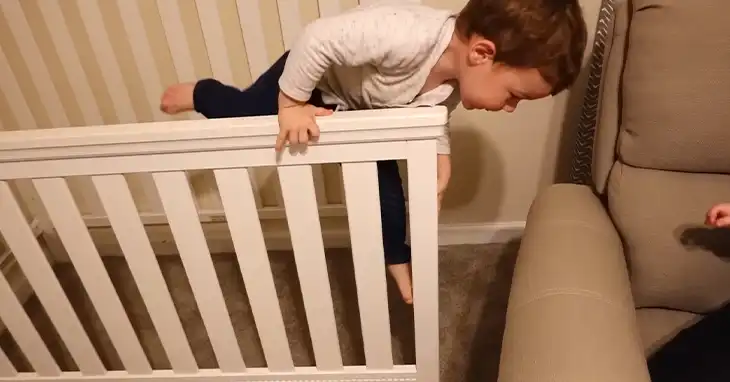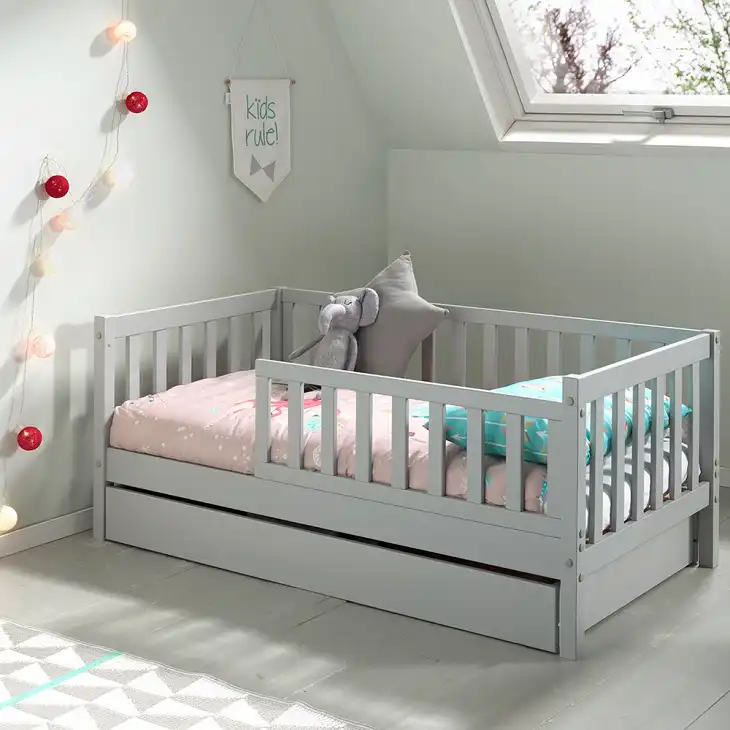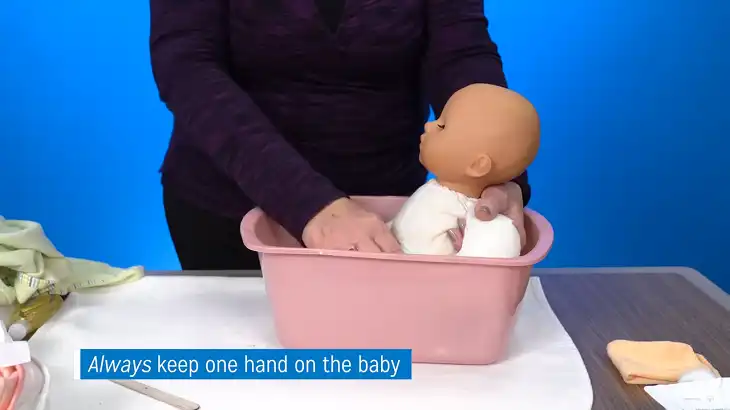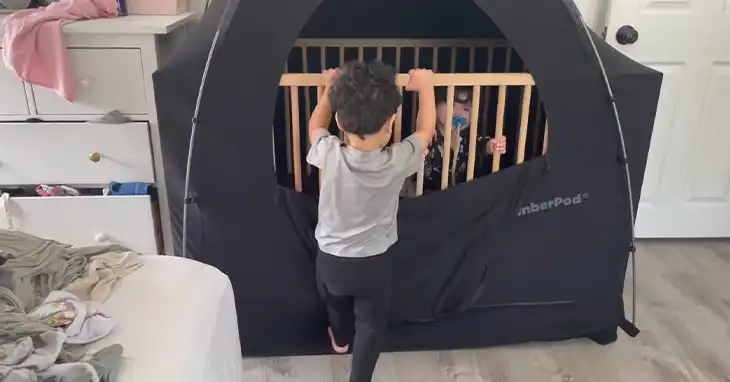What to Do When Your Toddler Climbs Out of the Crib?
While hilarious in hindsight, toddlers climbing out of cribs is no laughing matter due to the serious safety risks involved. Falls from cribs can lead to injuries like bruises, cuts, broken bones, and even more severe trauma. According to Stanford Children’s Health, over 25,000 crib-related injuries are treated annually in U.S. emergency rooms.
That’s why it’s crucial for parents and caregivers to address crib-climbing swiftly using a multi-pronged approach combining crib safety precautions, understanding underlying causes, implementing sleep training techniques, and ultimately transitioning to a toddler bed when developmentally appropriate.

Ensure Crib Safety First and Foremost
Before attempting any other strategies, do a thorough once-over of your crib situation to eliminate potential hazards:
- Ensure the crib is assembled correctly per manufacturer instructions with no loose, missing, or broken hardware, slats, or components. Even a seemingly minor issue increases fall risk.
- Check that the crib mattress fits snugly with no gaps where a limb could get trapped between the mattress and crib frame. Make sure mattress corner supports are secure.
- Remove all stuffed animals, pillows, bumpers, or soft bedding from the crib per American Academy of Pediatrics safe sleep guidelines. These can be used as step stools or present suffocation hazards.
- Get rid of any mobiles, crib toys, or objects secured inside the crib that could aid climbing efforts.
Making That Crib Escape-Proof
Even the most solidly constructed crib won’t contain an enterprising climber…but these techniques can make getting out much harder:
- Lowering the Mattress: Adjust the mattress height to its lowest setting so there’s minimal distance to the floor if the toddler does manage to go overboard. Don’t go to this level until around age 2.
- Sleep Sacks: These wearable blankets swaddle the child’s body while allowing mobility but restrict standing, climbing and hanging leg movements. You can even wear them backwards and secure with a safety pin for added escape resistance.

- Adjustable Height Cribs: Many modern cribs have the ability to lower or raise different sides. When your kiddo turns into a Houdini, rotate the crib 180 degrees so the tallest side faces the room interior as an extra hurdle.
Uncovering the Real Reasons for the Climb
Toddlers are hardwired to climb, explore and test boundaries – it’s just par for the course in this developmentally crucial stage. But sometimes crib-climbing can signal an underlying issue you’ll need to troubleshoot:
- Unmet Nighttime Needs: Something as simple as being thirsty, hungry, having a wet diaper or needing to use the potty can motivate escape efforts. Establishing a calming pre-bed routine to take care of all these needs makes night wakings less likely.
- Separation Anxiety: Bedtime is when separation anxiety often rears its head. Provide comfort with check-in reassurance, but avoid picking up or holding – that rewards the undesired behavior.
Comforting Bedtime Routine Examples:
[Table: Sample Calming Bedtime Routine]
The Right Sleep Training Method for Your Family

Once any underlying needs are addressed, you may need to sleep train not just for getting to sleep, but also for staying asleep all night in the crib. With so many philosophies, find a method that aligns with your parenting style.
- “Cry It Out” or Extinction Method: You put baby down awake and allow crying for a set period without responding until the next scheduled night feed.
Pros: Fastest results for some babies
Cons: Requires parental resolve. Can be stressful.
- Fading/Camping Out Method: You “camp out” in baby’s room and slowly move further away from the crib over time as they learn to self-soothe.
Pros: Provides reassurance for separation anxiety
Cons: Can take weeks to build independence
- The Chair Method: Each time baby cries, you sit in the chair without interaction until they fall back asleep. Move chair further away over time.
Pros: Responsive while minimizing sleep associations
Cons: Time-consuming
- Check and Console: Go in at timed intervals to briefly comfort but not pick up baby.
Pros: Balanced approach
Cons: Potential sleep association if timed checks are off
Whatever you choose, consistency is paramount – babies thrive on predictable routines and responses. Be patient as sleep training takes time, but it does work.
The Silent Return Technique
As your toddler grasps the sleep training plan for staying asleep, this simple technique diffuses the crib-climbing:
- If you see or hear crib disturbance, briefly wait to see if your toddler self-settles
- If not, wordlessly return your toddler to the crib
- Repeat as needed with zero interaction
Eventually, the “fun” of crib escape becomes pointless without any reward. Stay patient yet resolved – it can take hundreds of returns before success!
Positive Reinforcement
Offering praise and rewards for crib behavior can speed cooperation. Try:
- Sticker Charts: Issue fun stickers each morning they stay in the crib all night
- Stuffed Pals: Allow a special stuffie to stay for increasing time periods
- Verbal Celebration: Excited cheers and high-fives for rest champions!
Timing is key: only celebrate after a full night’s success to avoid mixed signals.
Creating the Ideal Sleep Environment
Having a calm, consistent and comforting sleep zone can facilitate restful nights:
- Clear any climbable household objects or furniture away from the crib zone
- Install childproof window coverings/guards to thwart escape routes
- Use a soft, dim nightlight and sound machine if desired for atmosphere
- Add a crib video monitor to keep an eye out for stirrings

When to Transition to a Toddler Bed
Most little ones show signs of being ready for a toddler bed between 2.5-3.5 years old, like:
- Frequent crib-climbing attempts
- Hitting the max height/weight limits for the crib
- Interest in/capability for getting into/out of a toddler bed
- Feeling crowded or cramped in the crib
Trust your gut instincts, but don’t rush this – switching to a bed too early can disrupt sleep. Let your toddler practice in the bed at naptime first to build experience.
Toddler beds are lower to the ground (around 10 inches high) with side rails to prevent tumbles. Check for secure guardrails with only 3.5 inch gaps to avoid getting stuck or injury.

What if Your Toddler Climbs Out of The Crib At Daycare
If your toddler is enrolled at a daycare or childcare facility, the crib-climbing phase presents unique considerations:
- Request that staff adopt suggested safety modifications like sleep sacks or lowered mattresses.
- Share your preferred sleep training approach so daycare staff can aim for consistency.
- Follow all safe sleep guidelines, including proper teacher-child ratios during nap periods to enable monitoring.
- Ask about the facility’s policies for managing climbing incidents and child safety protocols.
Is Climbing Out of Crib a Bad Sign?
Climbing out of the crib is actually a great sign that children are developing on track with achieving major milestones for their age like pulling up, standing, walking, and problem-solving. It’s our job as parents to keep them safe while not stifling that natural curiosity and physical capabilities.
Inconsistent responses at bedtime, like sometimes rocking to sleep and others letting a child cry, can increase sleep issues long-term. But kids truly thrive on knowing their caregivers’ responses will be reliable and predictable, which then allows them to build self-reliance.
In Summary
Discovering your toddler has mastered the art of crib escape can be alarming, but it’s also a typical childhood development milestone. Staying vigilant about crib safety, understanding root causes, implementing sleep training techniques, and knowing when to transition to a toddler bed are key steps in this phase.
With consistency, resourcefulness, and commitment to establishing healthy boundaries around sleep, this too shall pass. Restful nights for the whole family await on the other side of this crib-climbing season!






